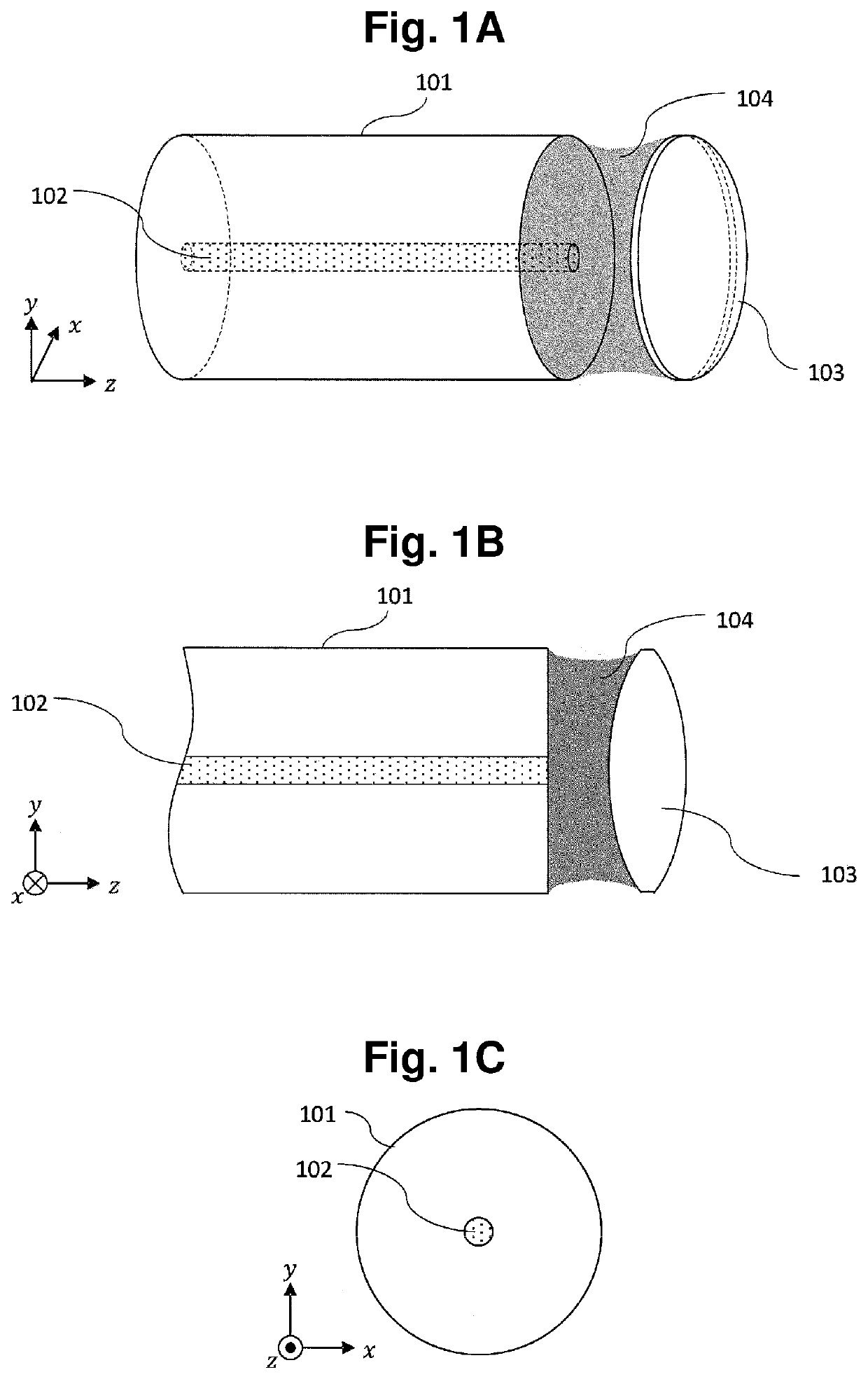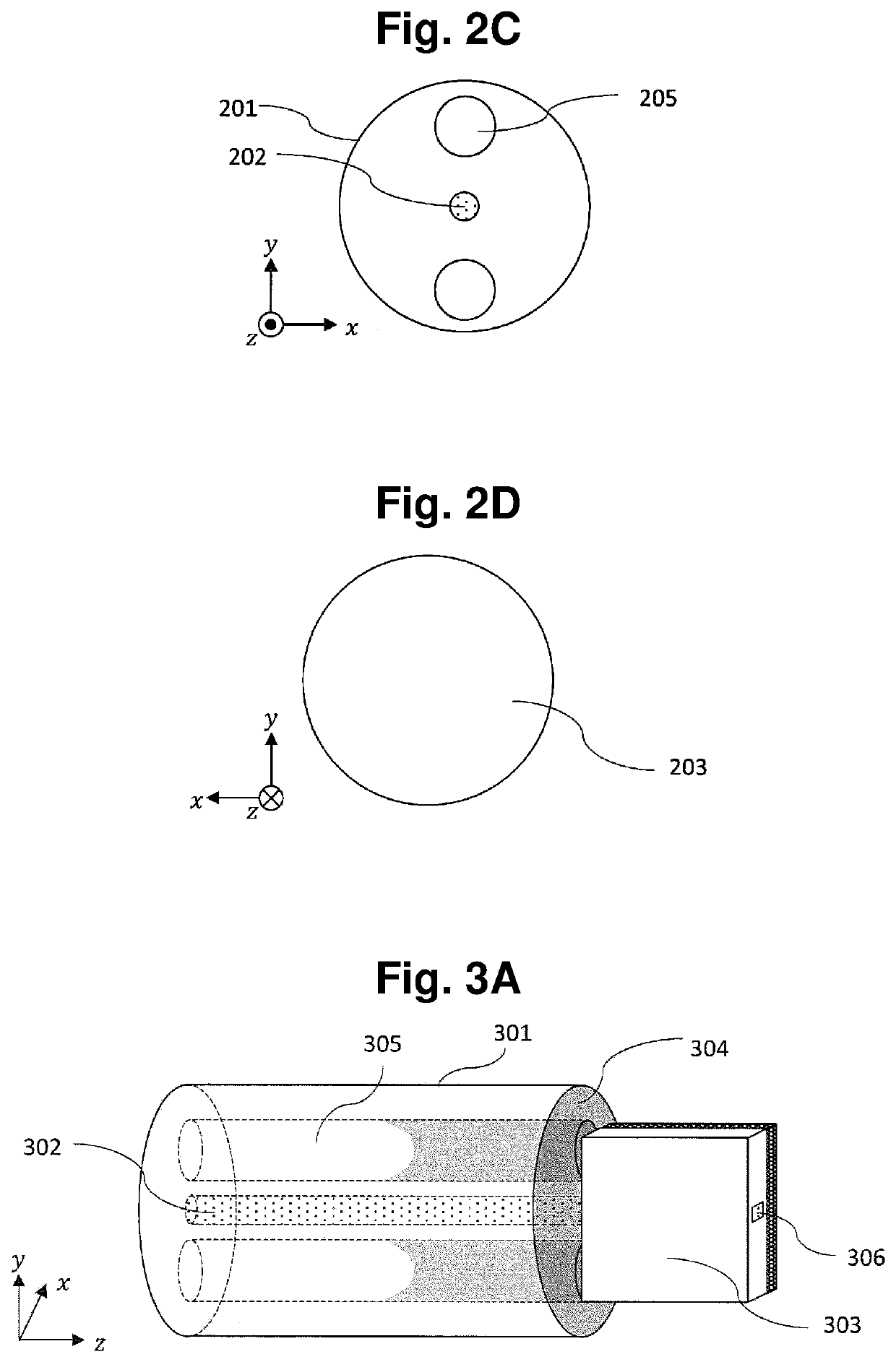Optical Connecting Structure
a coupling structure and optical technology, applied in the field of optical coupling structure, can solve the problems of reducing the coupling cost affecting the coupling effect of etc., to achieve the effect of reducing the coupling cost and reducing the coupling between optical elements and optical fibers
- Summary
- Abstract
- Description
- Claims
- Application Information
AI Technical Summary
Benefits of technology
Problems solved by technology
Method used
Image
Examples
first embodiment
[0047]As shown in FIG. 1A to FIG. 1D, an optical coupling structure according to a first embodiment of the present invention is an optical coupling structure where a lens 103 and an optical fiber 101 are coupled to each other by an adhesive agent 104. An optical fiber core 102 is formed in the optical fiber 101. The adhesive agent 104 is applied to a surface of the lens 103 which faces the optical fiber 101 and an end surface of the optical fiber 101 which faces the lens. By adhering the lens 103 to the end surface of the optical fiber 101 by the adhesive agent 104, the optical fiber 101 and the lens 103 are coupled to each other optically and mechanically by the adhesive agent 104.
[0048]As shown in FIG. 1A and FIG. 1B, both a contact angle which the surface of the lens 103 and a surface of the adhesive agent 104 make and a contact angle which the end surface of the optical fiber 101 and the surface of the adhesive agent 104 make are less than 90 degrees.
[0049]With such a structure,...
second embodiment
[0052]An optical coupling structure according to a second embodiment is an optical coupling structure where a lens 203 and an optical fiber 101 are coupled to each other by an adhesive agent 104 in the same manner as the optical coupling structure according to the first embodiment described above. As shown in FIG. 2A to FIG. 2C, the optical fiber 201 in the optical coupling structure according to the second embodiment is a so-called hole-formed optical fiber which includes holes 205 opening at an end surface in addition to an optical fiber core 202.
[0053]In this embodiment, the hole-formed optical fiber 201 includes, as the holes 205, hollow holes having a columnar shape which are formed in a clad portion parallel to the optical fiber core 202. That is, the hole-formed optical fiber 201 includes the hollow holes having a columnar shape which are formed parallel to a waveguide direction of the optical fiber 201. As shown in FIG. 2A to FIG. 2C, in this embodiment, as viewed from a z d...
third embodiment
[0061]As shown in FIG. 3A to FIG. 3E, an optical coupling structure according to a third embodiment of the present invention is a structure where a hole-formed optical fiber 301 and a PLC 303 are coupled to each other by an adhesive agent 304.
[0062]The configuration of the hole-formed optical fiber 301 is equal to the configuration of the hole-formed optical fiber 201 according to the second embodiment. That is, the optical fiber 301 includes, as holes 305, two hollow holes having a circular columnar shape formed parallel to an optical fiber core 302. That is, the optical fiber 301 includes two hollow holes having a circular columnar shape formed along a waveguide direction of the optical fiber 301. Two holes are formed at symmetrical positions with respect to the optical fiber core 302 as viewed from a y direction as shown in FIG. 3C.
[0063]On the other hand, as shown in FIG. 3A, FIG. 3B and FIG. 3E, a PLC core 306 is formed in the PLC 303.
[0064]As shown in FIG. 3B, in the optical c...
PUM
 Login to View More
Login to View More Abstract
Description
Claims
Application Information
 Login to View More
Login to View More - R&D
- Intellectual Property
- Life Sciences
- Materials
- Tech Scout
- Unparalleled Data Quality
- Higher Quality Content
- 60% Fewer Hallucinations
Browse by: Latest US Patents, China's latest patents, Technical Efficacy Thesaurus, Application Domain, Technology Topic, Popular Technical Reports.
© 2025 PatSnap. All rights reserved.Legal|Privacy policy|Modern Slavery Act Transparency Statement|Sitemap|About US| Contact US: help@patsnap.com



